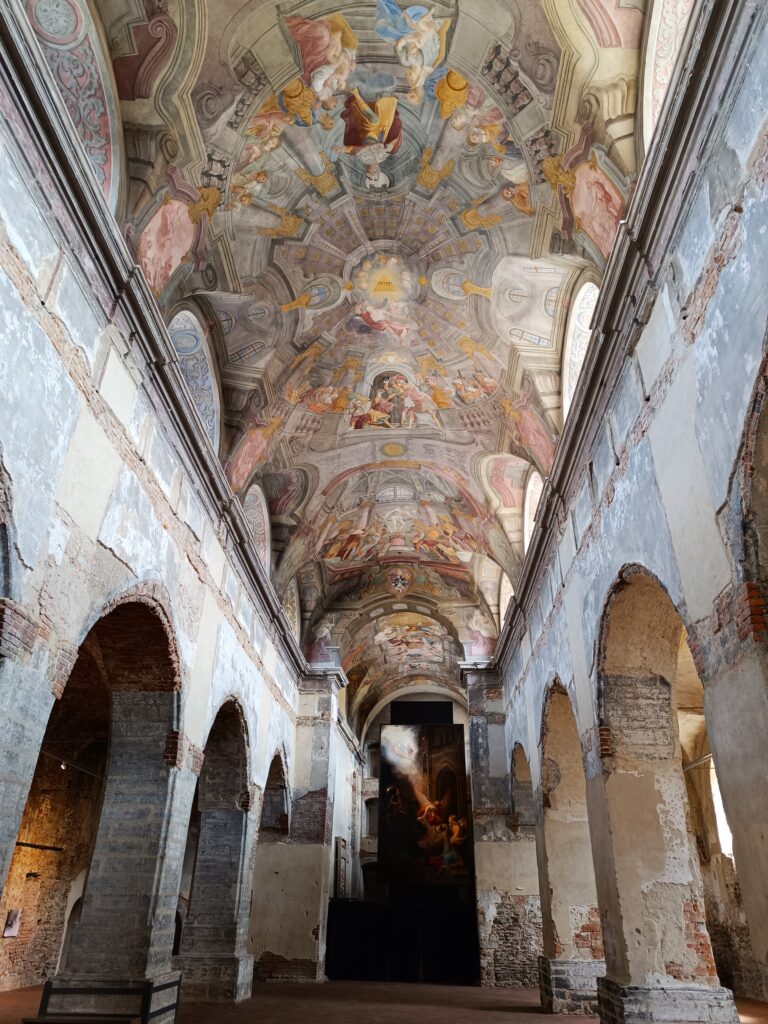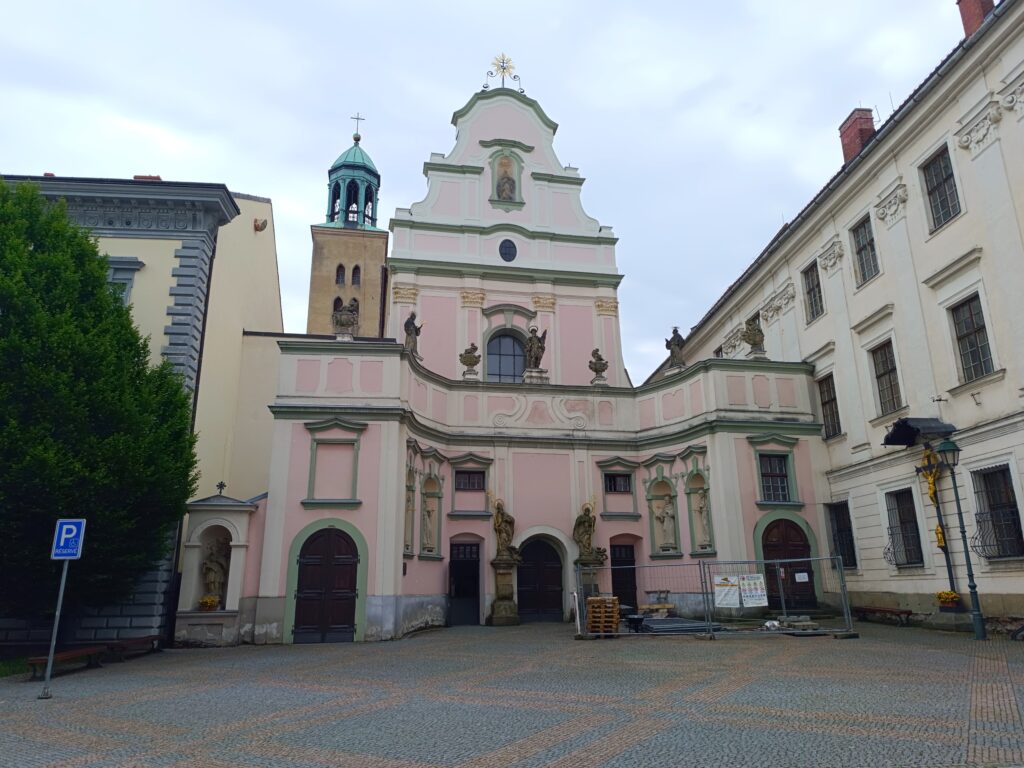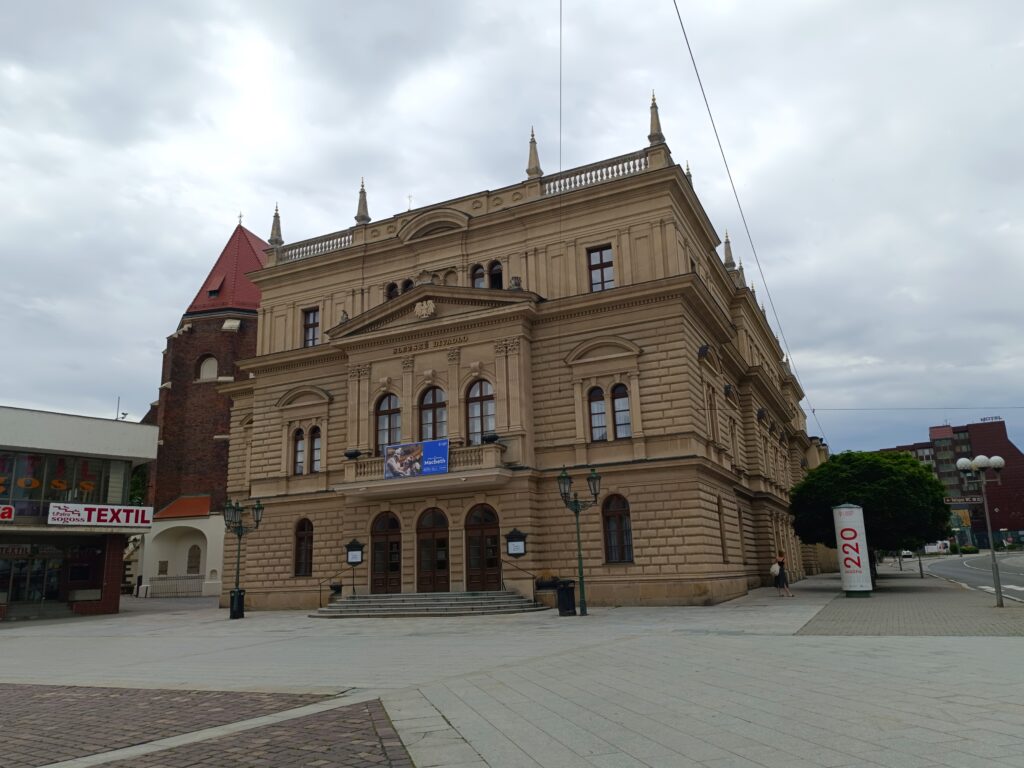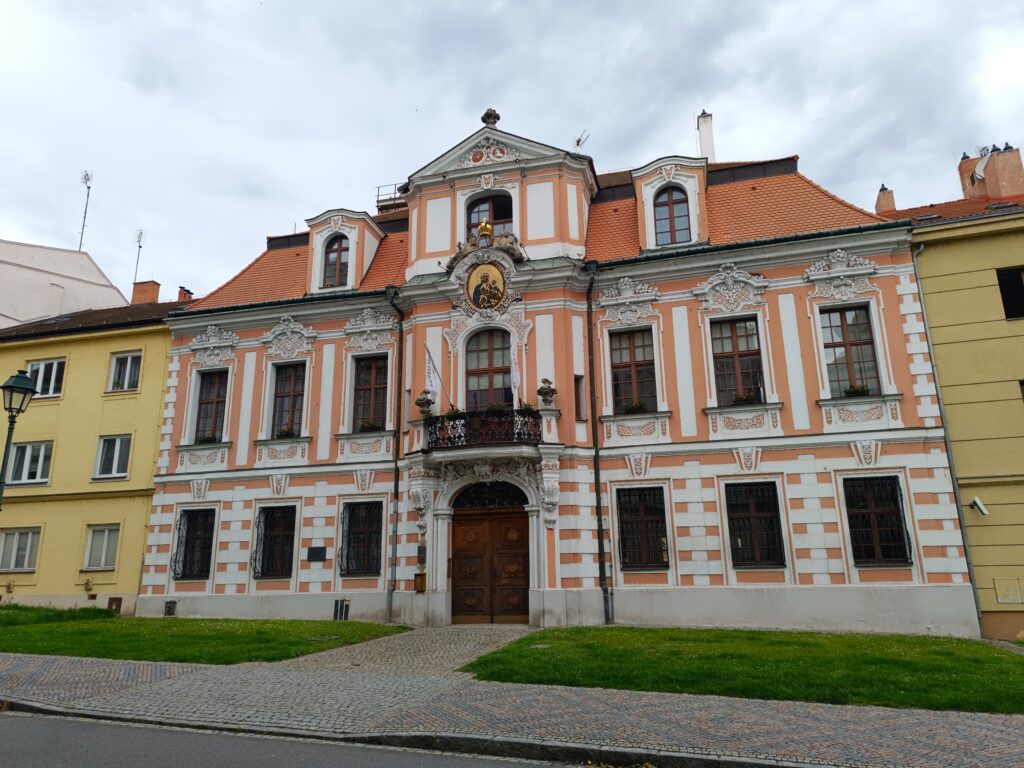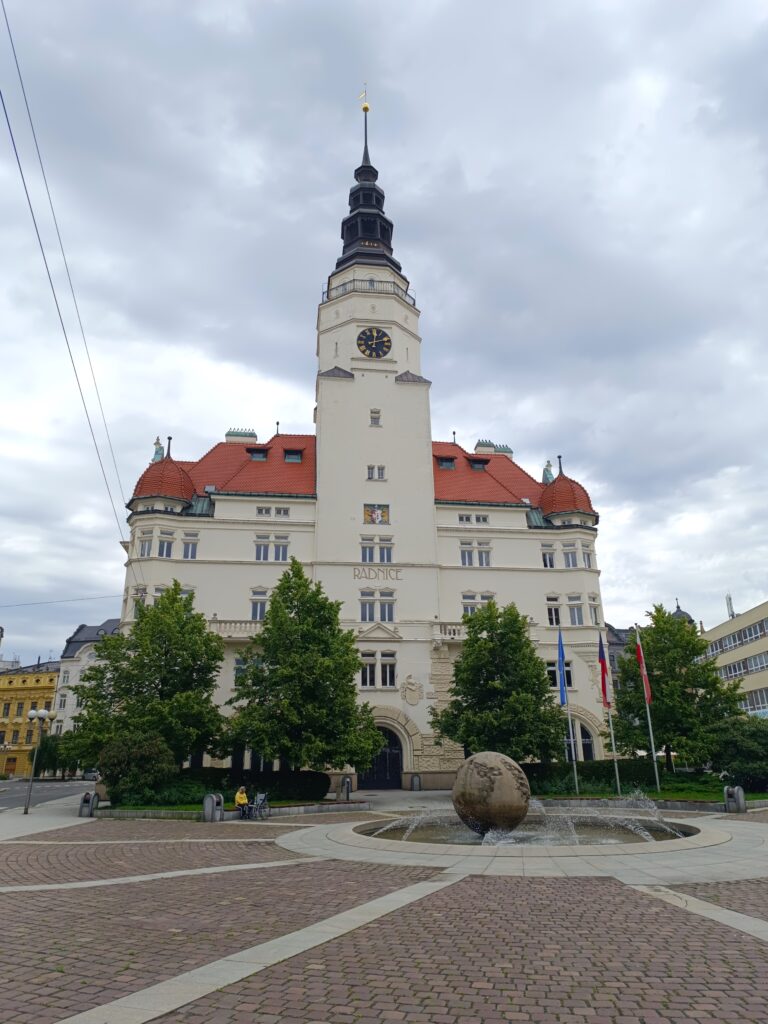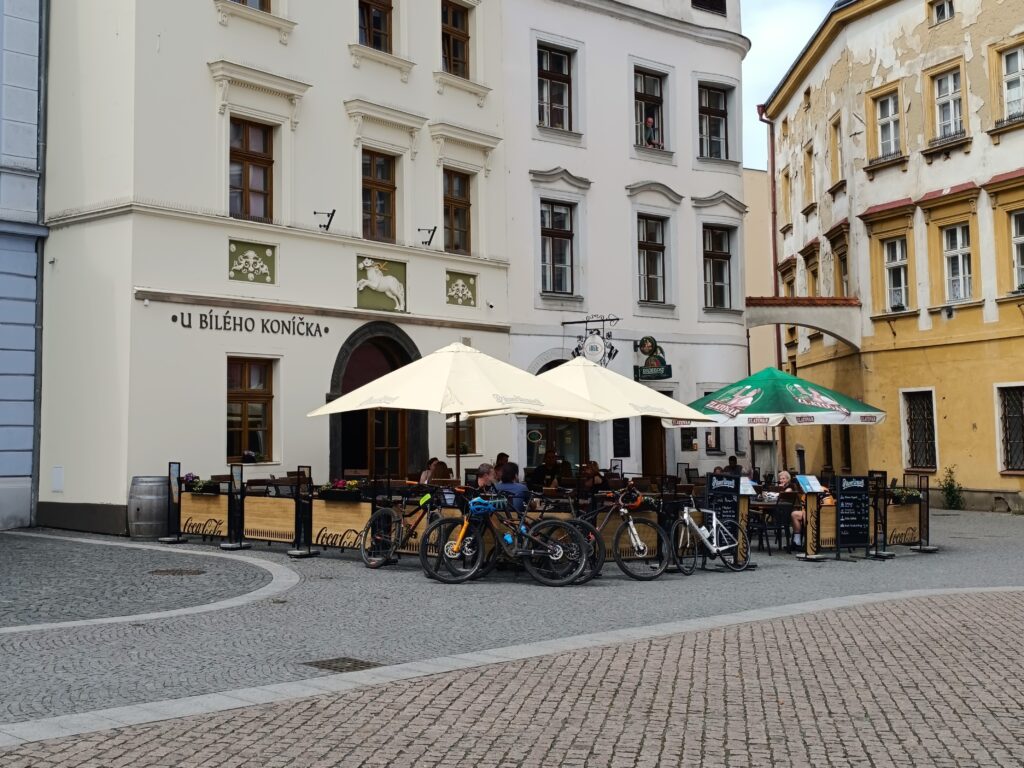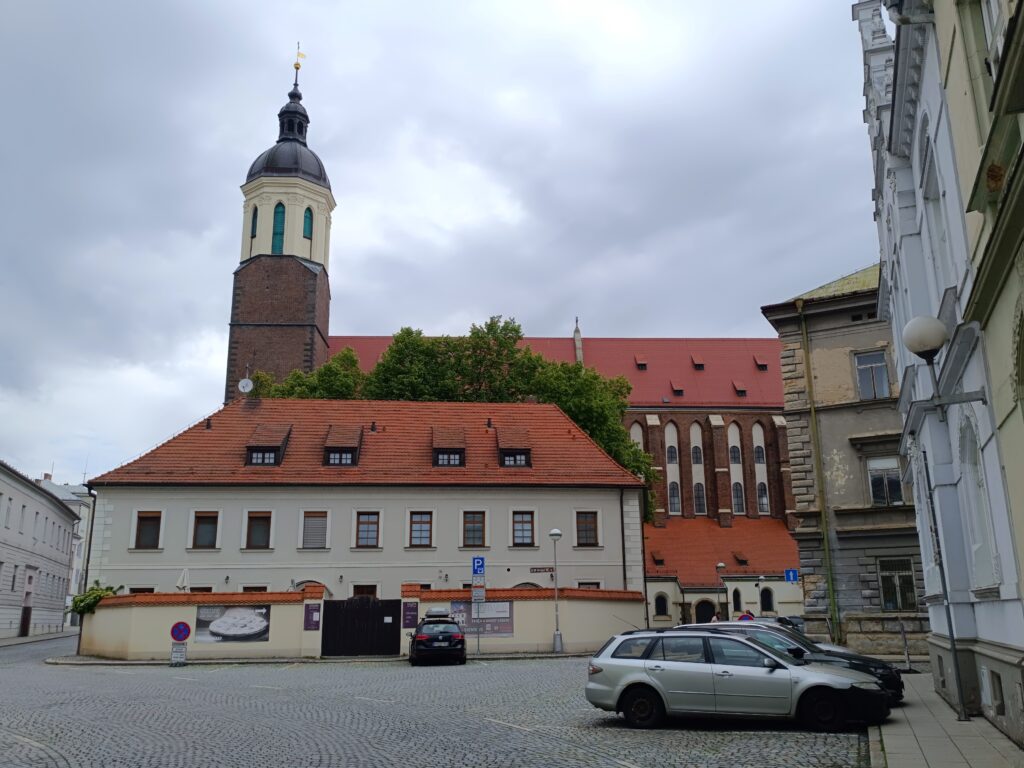All you need to know about the city of
opaVa
CZECH REPUBLIC
Sightseeing
The breathtaking monuments of this enchanting city are truly unique within all of Silesia. The tallest tower in the region and the largest brick Gothic structure in the Czech Republic, combined with numerous historic churches, create a one-of-a-kind, historical atmosphere.
curiosities
Opava is a city like no other. The local dialect, spoken only in this region, highlights its distinct cultural identity. It is also the birthplace of one of the most prominent Czech national poets. And to top it off—where else can you enjoy a meal in a 16th-century townhouse?
History
For centuries, Opava has played an important role in the history of Silesia. Its significance grew especially when it became the capital of Austrian Silesia—one of the regions of the Habsburg Monarchy.
CONTENTS
SIGHTSEEING
Dům umění
Admission: 80 CZK standard, 50 CZK reduced
Dům umění is a local cultural center primarily serving as an art gallery. It hosts temporary exhibitions, usually showcasing modern art. The gallery is located in a former Dominican monastery that dates back to the Middle Ages. One of the highlights of Dům umění is a site even more interesting than the gallery itself — the Church of St. Wenceslas.
This former Dominican church was built between the 13th and 14th centuries and was already adorned with intricate frescoes at that time, some of which have survived to the present day. Members of the local nobility were also buried here. In the 18th century, the church underwent a major Baroque renovation, including the addition of new fresco decorations.
St. Adalbert’s Church
Admission: Free
This richly adorned Baroque church from the late 17th century replaced an earlier 14th-century temple that once stood on the site. It was built primarily as part of the Counter-Reformation efforts to re-Catholicize the city, which at the time was inhabited mostly by Protestants.
Inside, you’ll find a portal bearing the Latin inscription Ad Maiorem Dei Gloriam (To the Greater Glory of God). A striking feature is the relief commemorating three Jesuit martyrs who were killed in Japan. The church also contains statues of Jesuit saints. A notable decorative element is the coat of arms of the House of Luxembourg, the ruling dynasty in the region at that time.
The interior of the church was carefully completed in the first half of the 18th century. Unfortunately, all wall paintings from that era were destroyed during the bombing of the city in World War II. Only a portion of the frescoes in the side chapels survived.
Church of the Holy Spirit
Admission: Free
The origins of the Church of the Holy Spirit date back to the 13th century, when it was built by the Franciscans. In the 14th century, a tomb was created beneath the presbytery for the Přemyslid dynasty of Opava—the then rulers of the city. Among those buried here were also King George of Poděbrady of Bohemia, selected nobles, and scholars. Unfortunately, after a fire in the late 18th century, the crypt was filled in.
The church was also the site of several important historical events. It hosted the assembly of King Vladislaus II Jagiellon of Bohemia and Matthias Corvinus, the King of Hungary.
In the 17th and 18th centuries, the church suffered significant damage due to wars, invasions, and fires. Reconstruction began in 1695, giving the building a Baroque appearance. The interior was adorned with statues referencing St. Francis, as well as sculptures of other saints—Bonaventure, Louis, and John of Nepomuk.
During World War II, the church burned down. After reconstruction, it was secularized by the communist authorities and served for years as an agricultural and forestry archive. Only after the return of local self-governance was the church returned to the Franciscan order.
Co-Cathedral of the Assumption of the Virgin Mary
Admission: Free
One of the most important buildings representing Brick Gothic architecture, and at the same time the most valuable Gothic monument built by the Teutonic Order. It is also the only co-cathedral in the Czech Republic—a co-cathedral being the second most important church in a diocese. In this case, the main cathedral is in Ostrava, within the Diocese of Ostrava-Opava.
The origins of the Co-Cathedral of the Assumption date back to the 13th century, when it was founded through the joint efforts of the Teutonic Order and the municipal authorities—who later competed for influence over the church. The building was gradually expanded, including the addition of towers. In the 15th century, an altar considered one of the most beautiful in all of Bohemia was created. Another valuable work is the Holy Trinity painting from 1452, which has survived to this day.
In the 16th century, Renaissance style began to influence the church—with new paintings and tombs being added. These tombs can now be admired in the western and southern vestibules. In the Chapel of Saint Anne, there is a painting of Saint John of Nepomuk from the 17th century—the oldest known depiction of this saint in Czech Silesia.
In the 18th century, the church was renovated in the Classicist style. At the turn of the 19th and 20th centuries, only minor changes were made, despite ambitious plans to restore its medieval character. A key moment in the church’s history came in 1996, when it was granted the title of co-cathedral.
Silesian Museum
Admission: 100 CZK standard, 50 CZK reduced
The oldest museum in the Czech Republic, the Silesian Museum dates back to 1814. In terms of the number of items on display, it is the third largest museum in the country. Its main building is equally impressive—constructed in the 19th century on the site of the former Opava Castle.
One of the museum’s main exhibitions is The Nature of Silesia, which features an extensive collection of animals. Visitors can find not only birds, mammals, and amphibians, but also various arthropods and mollusks. The exhibit also includes specimens of mosses, lichens, and fungi.
The second major exhibition is the Silesian Encyclopedia, devoted to the region’s culture and history. In an alphabetical format, it presents various elements related to Czech Silesia — from church furnishings and everyday objects used by former inhabitants, to informative panels about well-known figures connected with Opava.
In addition to permanent exhibitions, the museum regularly hosts temporary exhibits. In June 2025, these include displays on marine themes and an exhibition of modern art.
Upper Square
Admission: Free
The Upper Square has been the center of the city since medieval times. Its most important feature is the town hall tower, known as Hláska, which stands 60 meters tall and is one of Opava’s key landmarks. Its origins date back to the founding of the city. In the Middle Ages, the tower served as a watchtower, primarily used to spot fires. A municipal scale also stood nearby, playing a significant role in the local trading market. Over the centuries, the tower has undergone numerous renovations, the most recent major restoration taking place in 2006.
Another noteworthy building on the square is the Silesian Theatre, constructed between 1804 and 1805 in the Neoclassical style. It is one of the oldest theaters of its kind in the Czech Republic. At the end of the 19th century, it was remodeled in the Neo-Renaissance style, which has been preserved to this day. Interestingly, the theatre is still in operation, and regular performances are held there.
Lower Square
Admission: Free
The Lower Square is considered perhaps the most beautiful part of the city. It is home to the monumental Church of St. Adalbert. In front of the church stands a classic Marian column, a type of monument traditionally erected either as protection against plague or as an expression of gratitude for its passing.
One of the more intriguing—and controversial—elements of the Lower Square is the sculpture named Špion (which translates to “Spy”). Created in 2003, it is — according to some interpretations — meant to represent… an anteater? The sculpture has drawn criticism from residents, some of whom resent the city authorities for installing it. Many feel that its modern style clashes with the historic charm of the surrounding Baroque church and traditional townhouses.
Sobkův palác
Admission: Free
Sobkův Palace, also known as the Palace of the Sobek family, is a historic building dating back to the early 18th century. It is considered one of the most beautiful secular monuments in Opava. The palace was built in the Late Baroque style, and part of the original vaulted ceilings has survived to this day.
A Polish element can be seen on the palace façade—a mounted replica of the Black Madonna of Częstochowa. Today, the building is privately owned, and can only be admired from the outside.
CURIOSITIES
The Poet of Resistance from Opava
One of the most important citizens of Opava is Petr Bezruč. Born in 1867, during the time of the Habsburg Monarchy, he became one of the key Czech poets at the turn of the 19th and 20th centuries.
Although he was born in Opava, he was forced to move to Brno in his youth due to his father’s pro-Czech activism. Upon reaching adulthood, he began studying classical philosophy in Prague, but did not complete his degree. He found work as a postal clerk in a small town. In 1888, he published his first piece under the pseudonym Ratibor Suk.
In 1893, a close friend of his committed suicide. In the aftermath of this tragedy, Bezruč requested a transfer to Brno, where he continued working. A year later, his mother passed away, and the poet took on the responsibility of caring for his younger brother. He continued to write—in 1899, he attempted to publish three volumes of poetry, but due to Austrian censorship, only one was released.
A breakthrough in his literary career came in 1909, when he published his most famous collection, Silesian Songs (Slezské písně), consisting of 54 poems. His writing was deeply rooted in personal experiences—he suffered from a lung illness that caused bleeding, endured heartbreak, and experienced nervous breakdowns. Above all, his poetry was an expression of resistance to national and social oppression, and a manifesto for Czech identity in Cieszyn Silesia. His texts also included anti-German and anti-Polish sentiments.
Silesian Songs remained his only literary work, though Bezruč spent years perfecting it—adding new poems, altering rhythms, and changing words. The collection has no equivalent in Czech literature, with a style and subject matter that are entirely unique. Over time, Bezruč became increasingly reclusive, avoiding social life. He died in 1958.
Silesian Songs has seen 44 editions and has been translated into many languages. In 1945, Petr Bezruč was awarded the title of National Poet of Czechoslovakia. A museum in Opava is dedicated to his life and work.
A Culinary Journey Through Opava
An enjoyable way to spend time in Opava is by exploring its local culinary scene. One recommended spot is the popular restaurant U Bílého koníčka, which translates to At the White Pony.
The restaurant is housed in a historic townhouse that dates back to the 13th century. The building underwent major renovations in the 16th century, and its historic character from that period has been preserved. It is now listed as a protected cultural monument, and between 2004 and 2006, it underwent a full restoration. The quality of the work was recognized with the Facade of the Year 2005 award.
The restaurant’s interior is equally captivating. On the ground floor, visitors can admire beautifully decorated vaulted ceilings, which give the space a unique atmosphere and highlight its centuries-old heritage.
Monarchs vs. Revolution
Opava is also connected with a significant historical event—the second Congress of the Holy Alliance, also known as the Congress of Opava, held in 1820. It brought together representatives of the three main powers of the time: Russia, Prussia, and Austria.
The rulers—Tsar Alexander I, Emperor Francis I, and representatives of King Frederick William III of Prussia—met in Opava to address growing social and political unrest across Europe. They were particularly concerned about revolutions and the rising support for constitutional and liberal ideas, which threatened the conservative order established after the Congress of Vienna in 1815.
The congress lasted more than two months and resulted in an agreement confirming the mutual cooperation of monarchs to uphold the conservative order in Europe. It was decided that in the event of a revolution in any European state, members of the Holy Alliance would have the right to intervene militarily to restore order.
The Congress of Opava became a symbol of the conservative reaction against the European movements for freedom and one of the last major gatherings of monarchs in the post-Napoleonic era.
Prošu, smič se
For those interested in linguistics, it’s worth noting that the Opava region has its own distinct dialect, somewhat different from standard Czech. It belongs to the western group of the so-called Lachian dialects.
One of the main features of this dialect is the replacement of the vowel a with i, for example: smič se instead of the standard Czech smát se (to laugh). In the third person plural, the ending -u often appears instead of the typical Czech forms -jí, -í, or -ou. For example: oni prosí (they ask) becomes oni prošu. Some pronouns are also different from the standard.
It is important to note that all Lachian dialects are closely related to the Silesian language and form a transitional area between Moravian and Silesian dialects. In the past, some Polish linguists even classified them as a variant of the Polish language. Today, that theory is rarely accepted, though some features support it—such as stress on the penultimate syllable (just like in Polish) and the lack of vowel length distinctions.
This dialect also includes phonemes characteristic of Polish, but absent in standard Czech, such as dz, dž, or ł.
There Is Only One Beethoven
One of the more amusing stories connected to 19th-century Opava involves none other than Ludwig van Beethoven. In 1806, the composer visited a village near Opava, where he found himself in a conflict with a prince from the Liechtenstein family. He was pressured to perform a concert for French officers. Outraged, Beethoven left the estate immediately, leaving behind a now-famous statement:
What you are, you are by accident and by birth. What I am, I am by my own merit. There have been and will be thousands of princes—but there is only one Beethoven.
Beethoven returned to Opava once more in 1811. He attended a Mass in C major at the Church of the Holy Spirit. Although his hearing was already severely impaired, that didn’t stop him from reacting when the conductor struggled to lead the piece. Beethoven stood up, took the baton, and conducted the rest of the mass himself.
Brick Colossus
Perhaps a rather unusual piece of trivia is the record held by the Co-Cathedral of the Assumption of the Virgin Mary. It turns out to be the largest Gothic church in the Czech Republic built entirely of brick. The church is also notable for its tower, which stands at an impressive 102 meters tall. But that’s not its only record—it is also the tallest tower in all of Silesia.
HISTORY
From Peacock to Opava
In ancient times, on the site where the city now stands, two wealthy men pitched their tents. When they woke the next morning, they noticed merchants passing through the area—and immediately began examining various goods brought from the East. Among them were richly decorated knives, swords, and exotic spices. But the item that made the greatest impression on them was an extraordinary bird.
This marvelous creature was a peacock, which instantly became a source of dispute. The merchants didn’t know which of the two men to sell it to, so they promised to return in a year with another one. After a long quarrel, the men eventually reconciled. One of them decided to stay and founded a city on the spot. In memory of the argument over the remarkable bird, he wanted to name the new settlement after it. But Peacock seemed too short — and since the quarrel was about the peacock, he decided the town would be called about a peacock—in Czech, o páva.
Of course, this is only a legend. In reality, the city’s name likely comes from the languages of ancient peoples—Germanic and Celtic. The former suggests the word apa, and the latter ahawa — both meaning “water.” It’s most probable that the Czech name Opava is derived from these older roots.
A City by Royal Decree
In ancient times, a settlement of the Golęszyce tribe existed in this region. However, the first written records of it date back only to 1195, by which time it was already part of the Czech state. Not long after, in 1224, Opava was granted its first city rights, making it one of the oldest cities in the Czech Republic.
Just a couple of decades later, in 1247, the city received further privileges—including the right to hold annual fairs. Additionally, Opava was exempted from paying customs duties, a measure aimed at easing the lives of its citizens following the Mongol invasion of 1241.
A key moment in the city’s history came in 1269, when the King of Bohemia, Ottokar II of the Přemyslid dynasty, carved out Opava and its surrounding lands and granted them to his illegitimate son. Thus, Nicholas I became the first Duke of Opava, and the Duchy of Opava maintained a degree of independence for the next several centuries.
Opava Between Bohemia and Silesia
In the early 14th century, during a dynastic change in Bohemia when Henry of Carinthia came to power, the land of Opava was pledged to Bolesław III the Wasteful of Brzeg (more about Brzeg—here). It was not until the reign of the next king, John of Luxembourg, that the land was redeemed. Nicholas I was left only with the local castle, while the entire Opava region was reintegrated into the Bohemian Crown.
Nicholas I’s son, Nicholas II, initially joined a rebellion in Moravia against King John, but ultimately chose to support his rule. In recognition of his loyalty, he was granted hereditary control over the land of Opava in 1318. His title of Duke of Opava was also confirmed, meaning that his children would inherit power as vassals of the Bohemian kings.
Nicholas II pursued an active policy of expanding his influence. In 1337, following the death of his brother-in-law in Racibórz, he took control of those lands, creating the Duchy of Opava-Racibórz. In 1358, he participated in the baptism ceremonies of the Lithuanians. Thanks to a marriage alliance in 1361, he also managed—albeit briefly—to reclaim the previously lost Prudnik region for Opava.
In the Shadow of Jan Hus
After the death of Nicholas II in 1365, the rule over the duchy passed to his son, John I, with the exception of Prudnik, which returned to the dukes of Niemodlin. John I ruled alone until 1377, when—under pressure from his younger brothers and the local nobility—he decided to divide the territory, granting his siblings separate districts. He retained Racibórz, while control over Opava was handed to his two brothers. Additionally, Głubczyce and Krnov were separated from the duchy.
At that time, Opava was an important agricultural and craft center, with two market squares and three city gates. In the 14th century, the city also gained one of its most valuable historical landmarks—the Co-Cathedral of the Assumption of the Virgin Mary, built in the Gothic style. This church became the burial site for the deceased dukes of Opava.
Opava was jointly ruled by Przemek and Wenceslaus, but after Wenceslaus’s death, Przemek became the sole ruler. The early 15th century brought new challenges—the Hussite Wars began. After the execution of Czech reformer Jan Hus, Czech society rebelled against King Sigismund of Luxembourg, one of the main figures responsible for Hus’s death.
As a loyal vassal of the King of Bohemia, Przemek initially sided with the ruling Luxembourg dynasty. However, the Hussite forces grew stronger, winning battles and expanding into neighboring lands. In 1427, they reached Opava. To protect the city from destruction, Przemek decided to convert to Hussitism. Despite this, the city still suffered as a result of the war. Just four years later, in 1431, a large portion of Opava was destroyed by fire.
The Cross and the Crown
After the death of Przemek, power in the duchy passed to his sons. However, fate was not kind to them—one after another, they died rather quickly, and by 1452, only Ernest of Opava remained in power. Despite earlier promises made to his brothers, Ernest began selling off the family estate. Living beyond his means, he soon fell into debt. In 1456, he decided to sell the duchy to the Piasts of Opole. Not long after, Opava was bought back by George of Poděbrady, the Hussite King of Bohemia. He granted part of the duchy to his son, Victor, the Count of Kłodzko.
It’s worth noting that as early as the 15th century, Opava was regarded as part of Upper Silesia. This was due to its strong ties with nearby Racibórz, as well as its permanent detachment from the direct influence of the Bohemian Crown. The Opava branch of the Přemyslid dynasty functioned much like the Silesian Piasts, and were often related by blood.
Meanwhile, tensions in Bohemia escalated between the king and the Catholic Church. Pope Paul II revoked George’s right to the crown, and part of the Catholic nobility refused to obey him. The situation was seized upon by Matthias Corvinus, the King of Hungary, who attempted to take control of Bohemia. Years of conflict led to the division of the kingdom into rival factions.
Aware of the threat and the uncertain future of his son’s claim to the throne, George of Poděbrady decided to offer the Bohemian crown to the Jagiellonian dynasty. After his death, the Kingdom of Poland joined the war on the side of Bohemia. Ironically, however, Victor, George’s own son, sided with Matthias Corvinus. The conflict ended in a Jagiellonian victory—even Hungary came under their rule.
In the new political reality, Opava was granted to the loyal-to-Bohemia Duke of Cieszyn. After his death, the duchy was incorporated directly into the Bohemian Crown, thus ending the long history of relative independence of this part of Silesia.
53 Days of Siege and 30 Years of War
The 16th century brought another wave of the Reformation across Europe. Its symbolic beginning was marked by Martin Luther’s 95 Theses in 1517, a continuation of reformist ideas previously introduced by Jan Hus. By 1525, Lutheranism had started to rapidly spread in Opava, making it one of the most important Protestant centers in Silesia.
Meanwhile, significant political changes occurred—after the death of Louis II of Hungary and Bohemia in 1526, both Bohemia and Hungary came under the rule of the Habsburgs. This new dynasty, deeply aligned with Catholicism, strongly opposed the spread of the Reformation. Over the following decades, tensions between Protestants and Catholics in the region steadily grew.
By the early 17th century, the situation had become increasingly tense. In 1607, Catholic bishops launched an armed intervention in Opava in response to religious disputes with the city council. The siege of the city lasted 53 days. Shortly after, in 1613, the Duchy of Opava was granted to Karl I of Liechtenstein—a move aimed at intensifying the region’s re-Catholicization.
In 1618, the Thirty Years’ War broke out—one of the most devastating conflicts in European history. The Czechs, supported by parts of Silesia, rebelled against Habsburg rule. They were joined by Swedes, Germans, and Hungarians on the Protestant side. The decisive Battle of White Mountain ended in a victory for imperial forces, and Karl I of Liechtenstein, a staunch Habsburg supporter, was rewarded with the Duchy of Krnov, leading—for the first time since 1377—to the reunification of Opava and Krnov.
In the following years of war, Opava changed hands multiple times—first captured by the Danes, then by the Swedes. Repeated occupations and looting devastated the city and surrounding region. Even after the war ended in 1648, the situation remained difficult.
A City on the Edge of Empires
After the war, Evangelical Czechs were forced to leave the city, and their place was taken by German settlers brought in by the authorities. This marked the beginning of an intensive period of Germanization and re-Catholicization—the remaining Czech population faced persecution, and their participation in public life was significantly restricted.
Although the Liechtensteins formally ruled over the Krnov-Opava duchy, in practice they focused more on strengthening their dynasty, managing the County of Vaduz, and developing an impressive art collection. The family maintained close ties with the Austrian imperial court, and their main residence was in Vienna, where Johann Adam of Liechtenstein built a grand palace and engaged in financial activities, including running a bank.
A turning point in the region’s history came with the Silesian Wars of the 18th century—a series of three armed conflicts during which the rising power of Prussia sought to wrest Silesia from Austrian control. Interestingly, King Frederick II of Prussia was initially surprised by the success of his campaign—the original plan had been only to seize Lower Silesia, but military victories allowed Prussia to occupy much of Upper Silesia as well.
As a result of the Treaty of Breslau signed in 1742, the border between the two states was drawn along the Opava River. The city of Opava remained within the Habsburg Monarchy, although Austria lost a significant part of the former Duchy of Opava. From that point on, Opava assumed a new role—it became the main center of Austrian Silesia, and from 1793, it served as the capital of a crown land, the equivalent of a modern-day province.
A Czech City of the German Nation
The early 19th century marked a period of significant cultural development in Opava. In 1805, the Silesian Theatre—still operating today—was established, and in 1814, the second-oldest museum in Silesia opened its doors, which has also survived to this day. The city’s urban landscape began to change as well—in 1834, the old city walls were demolished and replaced with parks inspired by Viennese models. In 1892, the ruined castle of the Dukes of Opava, a symbol of the city’s princely past, was dismantled.
During this same period, Opava played an important political role. In 1820, it hosted the second Congress of the Holy Alliance—a meeting of the monarchs of Austria, Prussia, and Russia, aimed at suppressing constitutional and liberal movements in Europe. In 1849, the Provincial Government of Silesia was established, with six of its representatives serving in the Austrian parliament. At the same time, Silesia was designated a separate entity within the Habsburg Monarchy, and Opava became the capital of this new crown land.
At the turn of the 20th century, Germanisation significantly altered the city’s ethnic structure. By the early 1900s, Opava had around 30,000 residents—92% of whom identified as German, while only 7% were Czech. These processes also led to effective re-Catholicisation of the city—nearly all inhabitants were Catholic.
A New Life for Opava
The dynamics of the entire region changed with the outbreak of World War I, which led to the collapse of the Habsburg monarchy and the ultimate dissolution of the Austrian state. As a result, Austrian Silesia was divided between the newly established Republic of Poland and Czechoslovakia. Opava became part of the latter, marking the end of the Duchy of Opava.
Initially, the region continued to function as a separate administrative unit, but in 1928 Opava lost this status, resulting in the loss of many former privileges and political significance.
In 1938, Opava was annexed by the Third Reich, which established the so-called Opava Regierungsbezirk—a distinct administrative district with Opava as its capital. After heavy fighting in 1945, the city was captured by the Red Army. At the time, it was the most heavily damaged city in the region. In the following years, the German population was expelled and replaced by Czech settlers.
After the war, Opava was gradually rebuilt. The Dům umění was opened, hosting exhibitions and cultural events. After the fall of communism, the city was granted statutory city status, meaning its administration operates under its own municipal charter. The Silesian University was also established, emphasizing both the city’s Silesian roots and its historical significance in the region.
Today, the residents take pride in their Silesian heritage, which they express in many ways. Opava remains a key cultural center and one of the most historically important cities in all of Silesia.
Oko na Świat © Artur Gołębiowski

